California is home to a diverse array of spiders, with the state’s varied ecosystems providing ideal habitats for numerous species. Among the California spiders, you’ll find both common and unique varieties, such as the California trapdoor spider and the Mediterranean Spiny False Wolf Spider.
These spiders in California contribute to the rich biodiversity of the region, playing crucial roles in controlling insect populations and maintaining ecological balance.
Continue reading the article to explore the features and identification of 72 types of spiders that can be found in California.
Different Types of California Spiders
False Black Widow
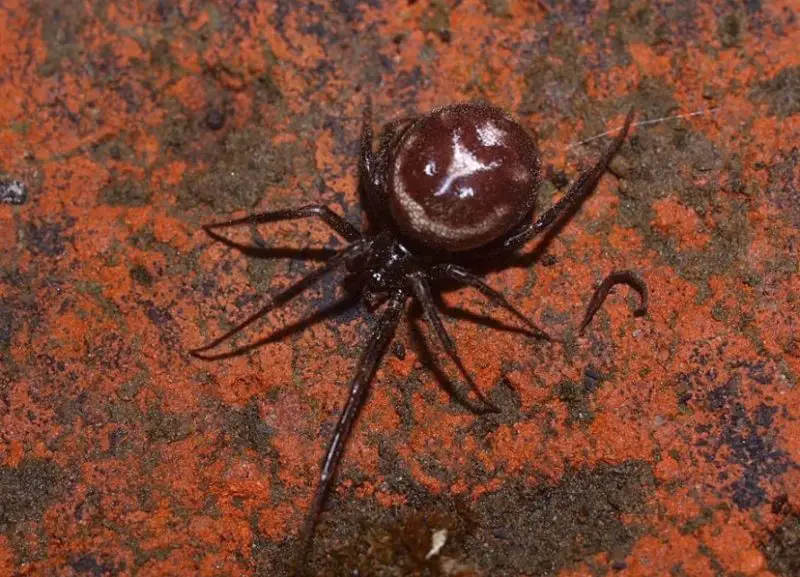
The false black widow (Steatoda grossa), also known as the cupboard spider, is often mistaken for the venomous black widow. Found worldwide, including California, females can grow up to 10.5mm and have a dark, bulb-shaped abdomen with colors ranging from black to purple-brown and light markings.
Unlike black widows, they lack a red hourglass. Although they have poor eyesight and rely on vibrations, their bites are considered medically significant, causing symptoms like blistering, pain, muscle spasms, fever, and sweating.
Cross Orbweaver
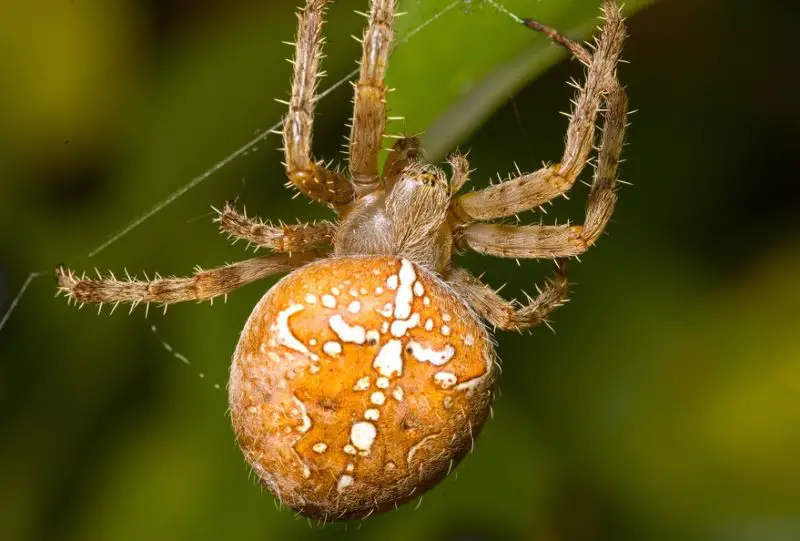
The cross orbweaver (Araneus diadematus), also known as the European garden spider or pumpkin spider, varies in color from orange to brown, with some being light yellow or dark gray.
They have distinctive white markings on their abdomen. Females are larger, reaching about 20mm, while males grow to 13mm. Notably, females often consume the male after mating.
Spotted Orbweaver
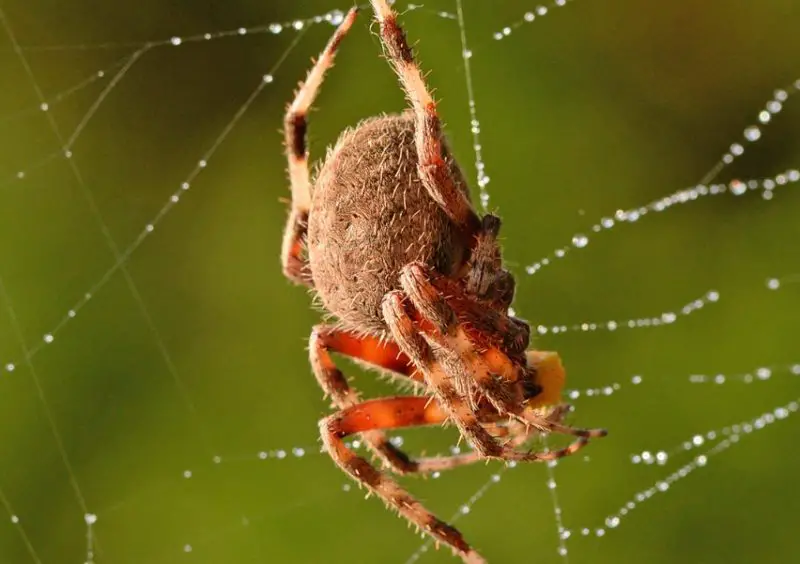
The spotted orbweaver (Neoscona crucifera), also known as the Hentz orbweaver or barn spider, is recognized for its large webs, which can span up to two feet in diameter. Their coloration ranges from orange and red to tan or yellowish-brown, with some featuring light abdomens or zigzag patterns.
Covered in bristles, they are typically found in fields, parks, backyards, and gardens. As nocturnal spiders, they are rarely seen during the day.
Western Spotted Orbweaver
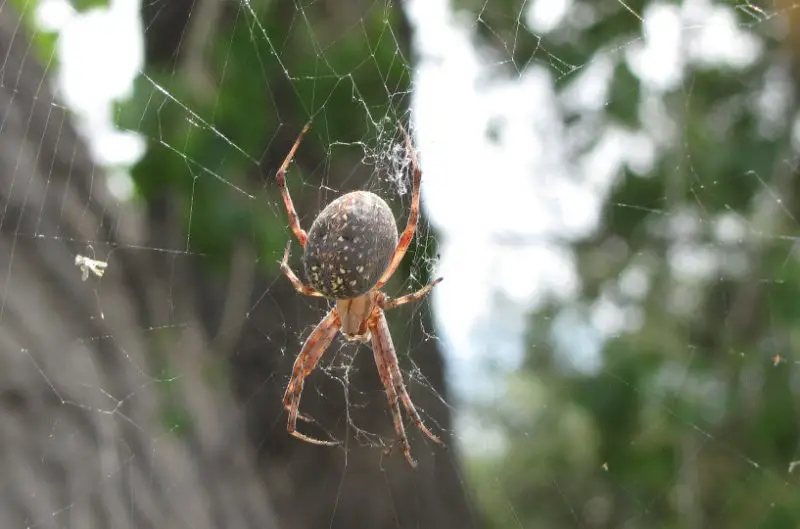
The western spotted orbweaver (Neoscona oaxacensis), also known as the zig-zag spider, is a large spider with females reaching up to 18mm and males about 13mm in body length.
They are notable for their distinctive light central band with a wavy border on their abdomen. These spiders are commonly found in gardens and outdoor areas.
Woodlouse Spider
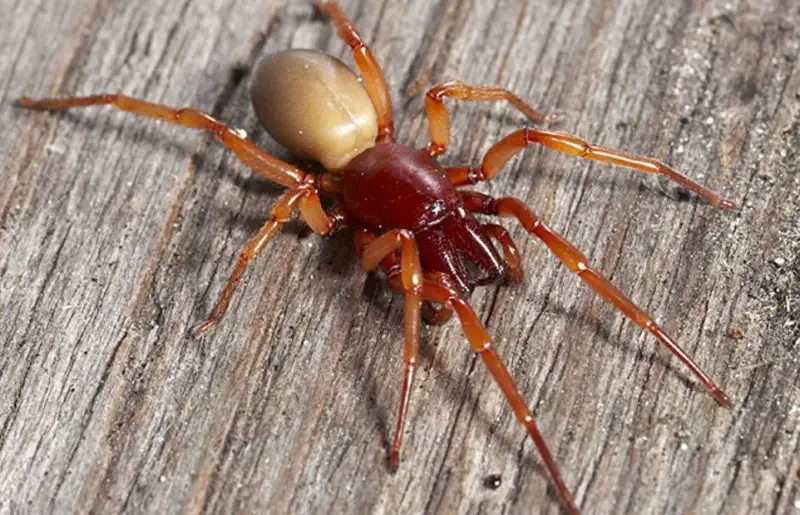
The woodlouse spider (Dysdera crocata), also known as the woodlouse hunter or pillbug hunter, primarily preys on woodlice. Females grow up to 15mm in body length, while males reach about 10mm.
These spiders have orange to dark red legs and heads with a yellowish-brown or beige abdomen. They are commonly found in damp, sheltered environments where woodlice is abundant.
Buttonhook Leaf-beetle Jumping Spider
The buttonhook leaf-beetle jumping spider (Sassacus vitis) is a North American spider, growing to about 5mm in body length. Females are larger than males, which are typically dull in color.
This jumping spider preys on small insects and flies and poses no harm to humans. Its name reflects its distinctive appearance and behavior.
Green Lynx Spider

The green lynx spider (Peucetia viridans) is a vibrant green spider that blends into green plants. As the largest member of the Oxyopidae family in North America, females reach about 22mm in body length, while males are half that size.
They feature a red patch between the eyes, red spots on their bodies, and white hairs around the eyes. Their legs are yellow to green with long black spines. Gravid females may change color based on their environment, a process that can take up to two weeks.
Desert Tarantula

The desert tarantula (Aphonopelma iodius), also known as the great basin blonde or Fresno County blonde, is commonly found in California’s desert regions. These tarantulas live in webbed burrows with silk or dirt plugs that shield them from heat and predators.
Although they are not harmful and prefer to flee rather than attack, their bite can be painful despite their venom not being dangerous to humans.
California Turret Spider
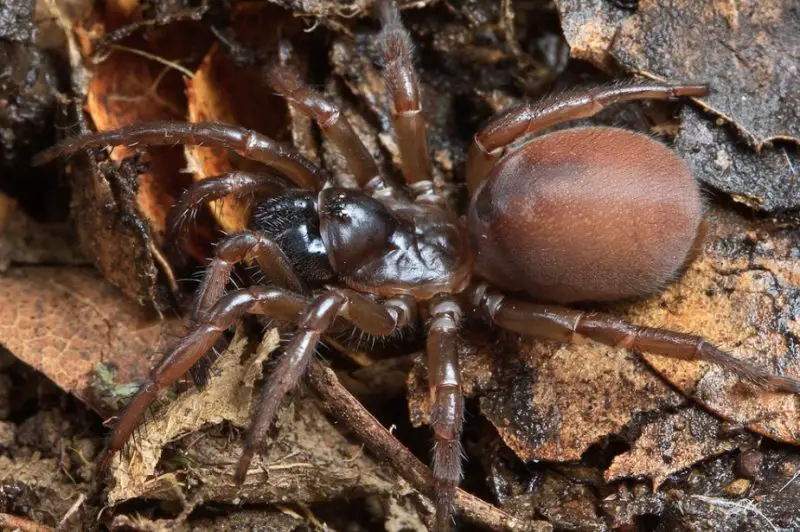
The California turret spider (Aphonopelma iodius) is native to Northern California and creates burrows in moist woodlands near streams and thickets. Growing up to 18mm in body length, these spiders are found in the Coastal Range and Sierra foothills.
They hide during the day, often in small turrets made of plant debris, which can be up to eight inches deep.
Colonus hesperus
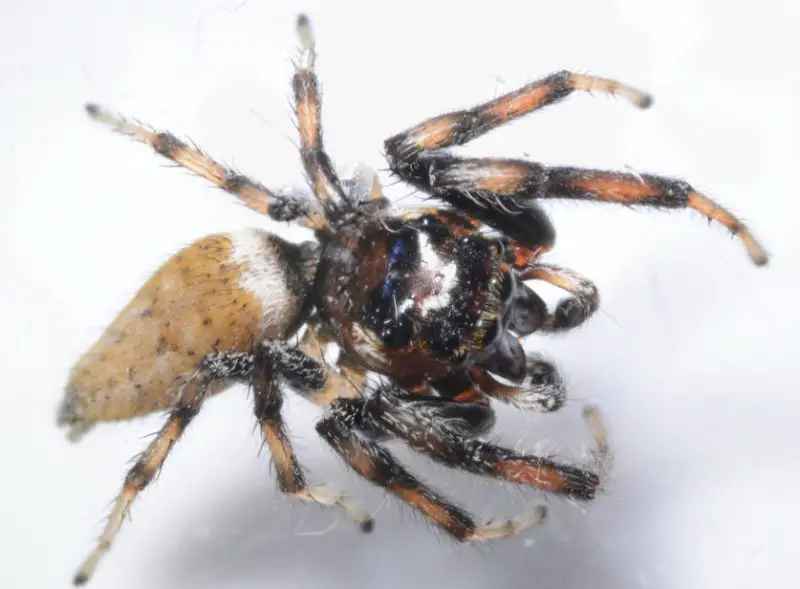
Colonus hesperus, a jumping spider from the Salticidae family, is commonly found in the United States. Unlike web-spinning spiders, it is an ambush predator that relies on its remarkable jumping ability to capture prey quickly.
The spider uses a single silk thread to reduce the risk of escape, then drags the captured prey to its web to feed when ready.
Marbled Cellar Spider
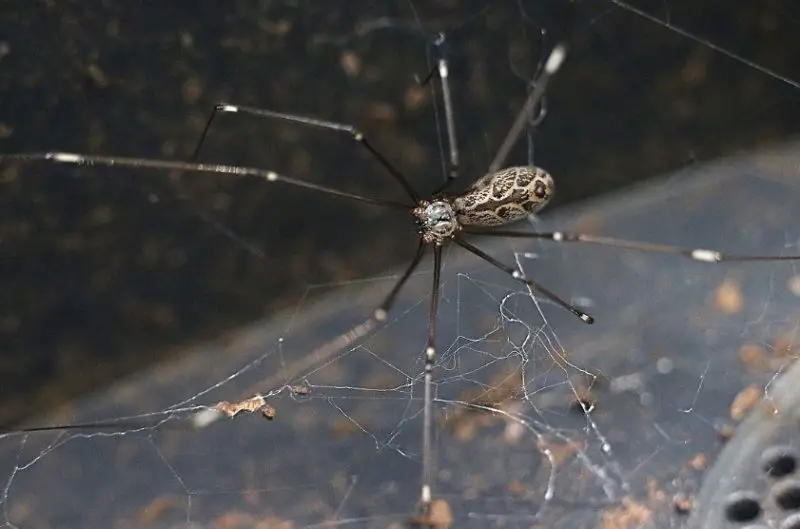
The marbled cellar spider (Holocnemus pluchei), also known as daddy long legs, is a common household spider found in basements, eaves, and attics. With negligible size differences between males and females, they have long, fragile legs with white and black circles at the joints.
Native to Europe and North Africa, they are now common in Southern California. While venomous, they are generally harmless to humans, with rare allergic reactions documented in asthmatic individuals.
Mouse Spider
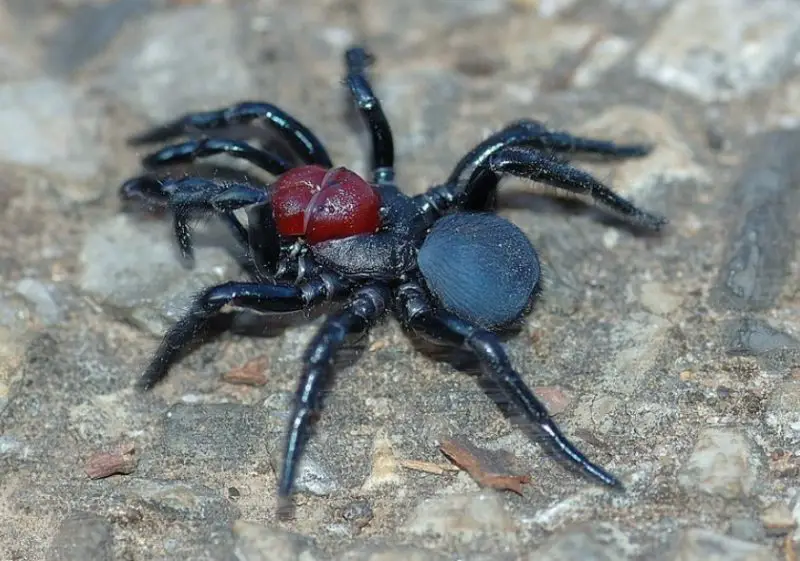
The mouse spider (Scotophaeus blackwalli), part of the Gnaphosidae family, is a nocturnal spider found under bark and in holes.
Females are larger, reaching about 12mm in body length, while males grow to around 9mm. They have a dark brown head with a gray to brown, hairy abdomen.
Goldenrod Crab Spider
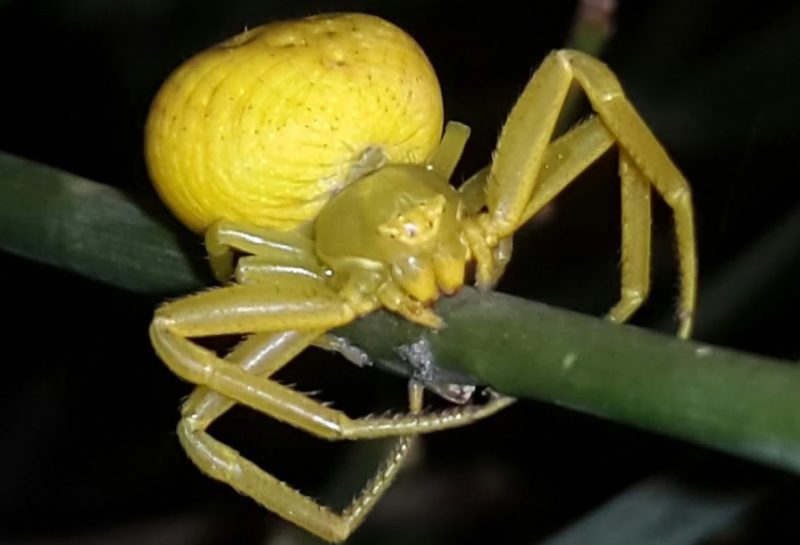
The goldenrod crab spider (Misumena vatia), also known as the flower crab spider, is found throughout North America, particularly on goldenrod and milkweed plants. Females are larger, reaching 10mm in body length, while males are about 5mm.
Unique among spiders, they can walk forward, sideways, and backward. They can change color during molting, shifting between pale green, pink, or yellow with a white pattern, blending with their environment.
Yellow Garden Spider
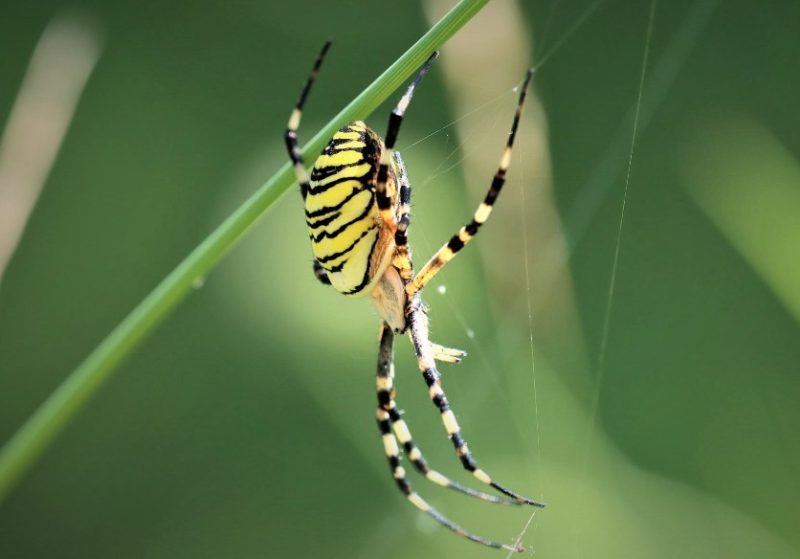
The yellow garden spider (Argiope aurantia), also known as the writing spider, is a striking black and yellow spider first described in 1833. Common in California, females grow up to 28mm, while males reach 9mm.
Their webs are typically located in sunny fields or near the eaves of homes. Though they will bite if provoked, their venom is harmless, comparable to a bee sting.
Brown Widow
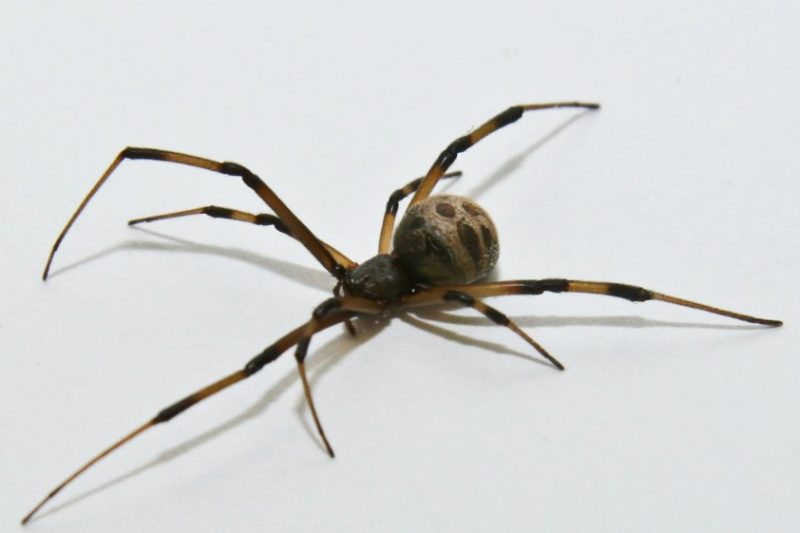
The brown widow (Latrodectus geometricus), also called the brown button spider or geometric button spider, is smaller and lighter than the black widow. Its color ranges from dark brown to black or tan with grayish tones. A notable identifying feature is the hourglass shape on its abdomen, which is a bright orange to yellow. Despite its less menacing appearance, caution is still advised as it can deliver a painful bite.
Noble False Widow

The noble false widow (Steatoda nobilis) features a brown, bulb-shaped abdomen with cream markings resembling a skull and red to orange legs. Females grow up to 14mm, while males reach 7-11mm.
Common year-round both indoors and outdoors, they inhabit various environments from fence posts to cacti and are prevalent in urban California. Juveniles live in small crevices, and while male bites are less severe, female bites can cause intense pain.
Western Black Widow
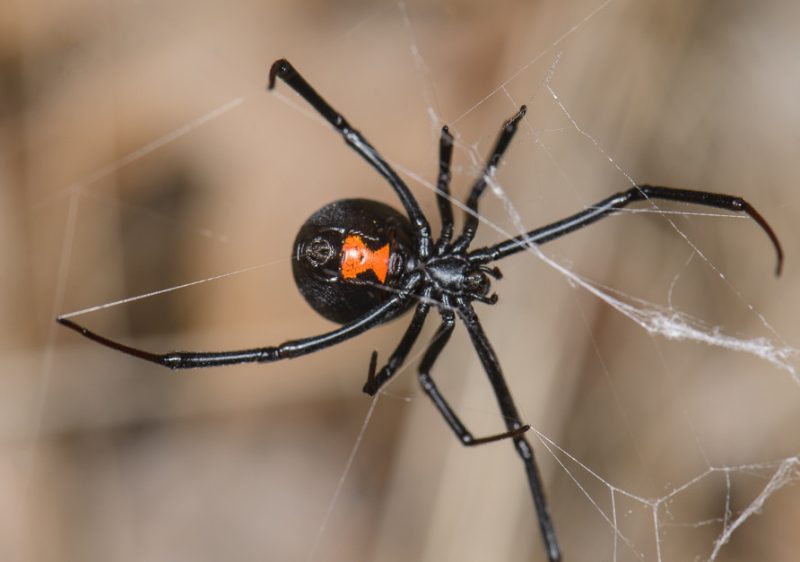
The western black widow (Latrodectus hesperus) is a highly venomous spider found in North America, with females reaching up to 16mm in body length. They are black with a red hourglass shape on their underside, which may also be yellow or white.
Males are smaller and tan with light stripes. Female bites can cause severe pain, swelling, and nausea, so immediate medical attention is advised if bitten.
Bold Jumping Spider

The bold jumping spider (Phidippus audax), also known as the daring jumping spider, is a common and harmless species in North America. Females grow up to 18mm, while males reach about 15mm.
They are black with distinctive spots and stripes on their legs and abdomen. With excellent vision, they are ambush predators that use their jumping abilities to capture prey in open areas, such as grasslands, fields, and gardens.
Long-bodied Cellar Spider
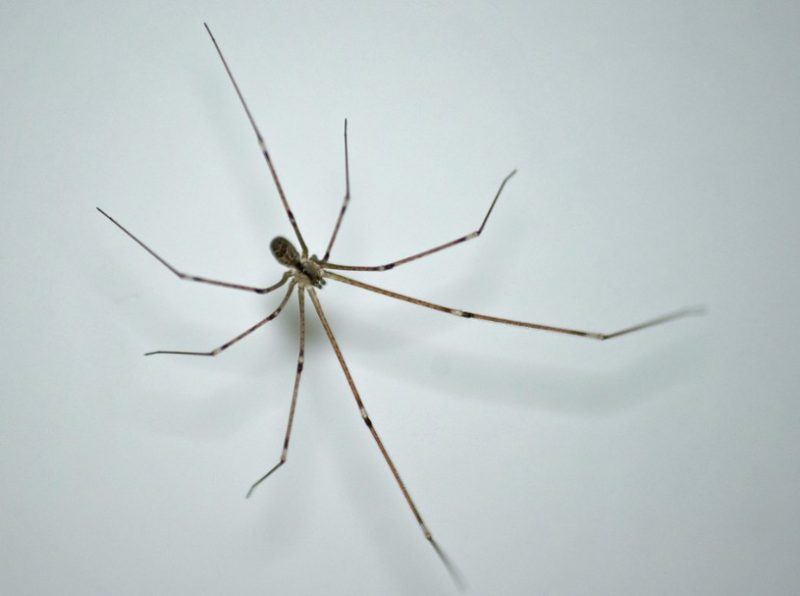
The long-bodied cellar spider (Pholcus phalangioides), commonly known as the daddy long-legs or skull spider, has a head space resembling a human skull. Females reach up to 8mm in body length, with males being slightly smaller. Their leg span can be up to six times their body length.
Found in rooms, garages, cellars, and caves, they are harmless to humans and not considered medically significant.
Silver Garden Orbweaver

The silver garden orbweaver (Argiope argentata), also known as the silver argiope, is recognized by its silver head and preference for warm, dry environments. Found in Southern California, Florida, Arizona, and Texas, these spiders create UV-reflecting webs that attract pollinating insects.
Females can grow up to 12mm, three times larger than males. Their UV-reflecting backs and dark brown abdomens with a yellow stripe help draw in insects.
Johnson’s Jumping Spider
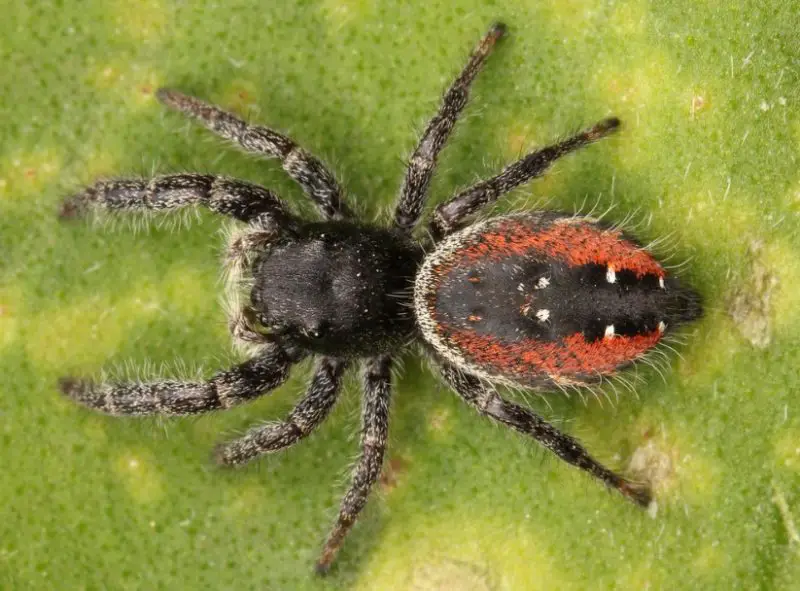
Johnson’s jumping spider (Phidippus johnsoni), also known as the red-backed jumping spider, is one of North America’s largest jumping spiders. Adults reach about 1cm in length and are mostly black with a bright red abdomen.
Females have a distinctive black central stripe. It is often mistaken for the venomous redback spider but is harmless.
Banded Garden Spider

The banded garden spider (Argiope trifasciata) is native to North America, known for its impressive webs up to two meters in diameter. Females, larger and often hanging upside down with legs in a cross shape, tend to stay in their webs. Males, smaller, build webs nearby.
These spiders use venom to immobilize prey caught in their non-sticky webs. They are completely harmless to humans.
Northern Yellow Sac Spider
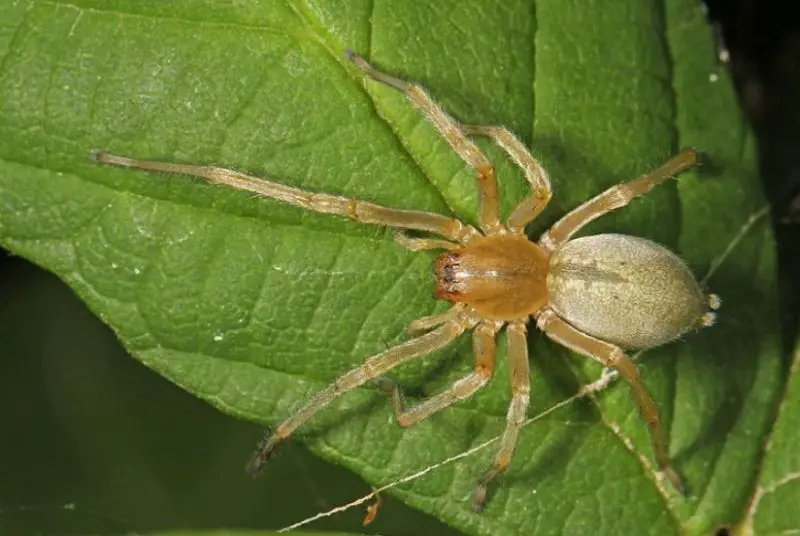
The northern yellow sac spider (Cheiracanthium mildei) is tan or pale green with dark brown markings. Adults reach up to 10mm in body length, with the front pair of legs significantly larger than the others.
Commonly found inside homes, they are not dangerous but may deliver a painful bite if threatened.
Grey House Spider

The grey house spider (Badumna longinqua) has females reaching up to 15mm in body length and males about 11mm. They are covered in light gray hairs with spot markings on their head and abdomen. Their legs are purple to brown with striped hairs.
These spiders are commonly found in homes and are generally harmless to humans.
Phidippus adumbratus
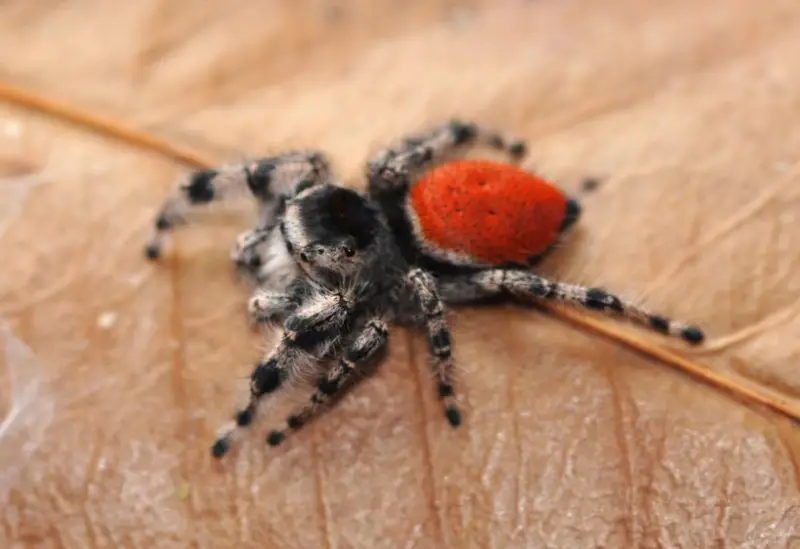
Phidippus adumbratus, a member of the Salticidae family, inhabits dry grasslands, deserts, and fields, often seen on cacti and shrubs. Females can grow up to 22mm and are black with orange on the head and abdomen, while males are smaller, up to 3.3mm, and exhibit red or orange coloring with dark pedipalps.
These spiders build nests under sunflower leaves and cactus thorns.
Gray Wall Jumping Spider
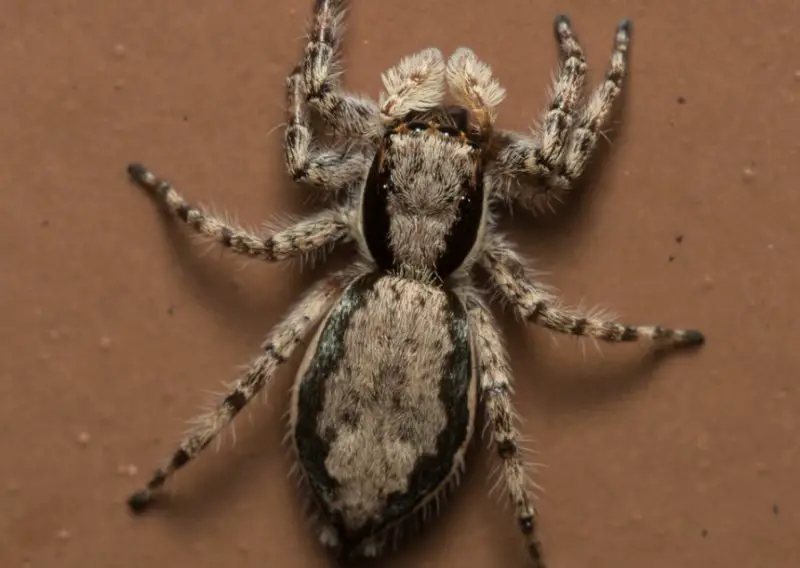
The Gray Wall Jumping Spider (Menemerus bivittatus) is a flattened spider with short gray to white hairs and dark brown bristles near the eyes. Males are around 9mm long with a black stripe and white stripes on the abdomen, while females are lighter with more brown, two black bands, and a white stripe on the abdomen.
Native to Africa, they have been introduced to California and are commonly found outside homes, barns, and sheds.
Western Lynx Spider
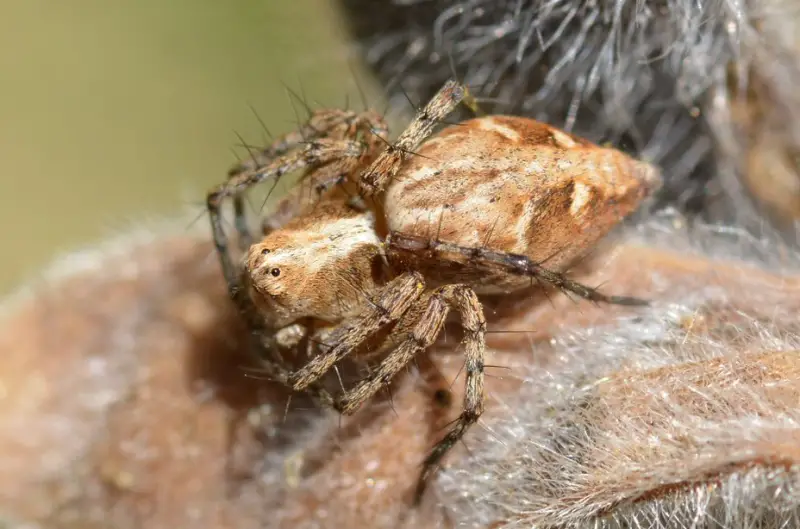
The Western Lynx Spider (Oxyopes scalaris) is a small, spiny-legged spider found in yards, fields, and gardens. They grow up to 7mm in body length and are ambush predators that stalk and pounce on prey.
Females have pale yellow heads with white and dark bands on their abdomen, while males have copper-colored heads and a silver-green or purple abdomen. Their webs are not used for capturing prey.
Habronattus pyrrithrix
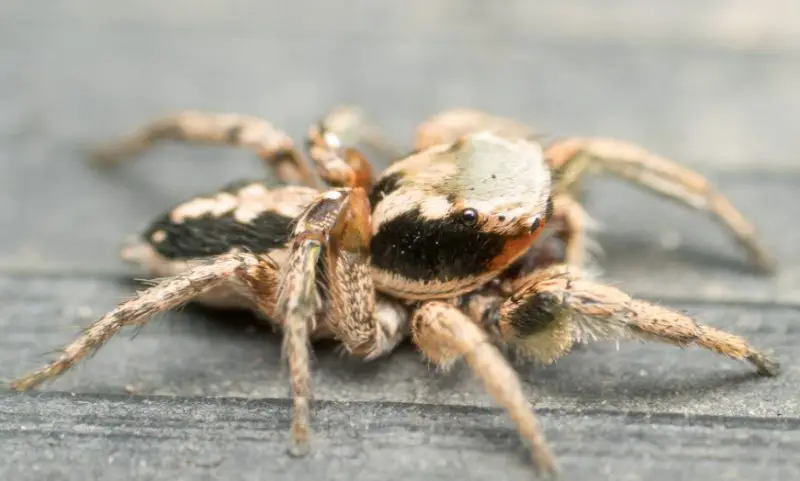
Habronattus pyrrithrix is a jumping spider found in the southwestern United States. Males display bold black stripes, while females are uniformly colored. They use their webs as retreats and to protect egg sacs. These ambush spiders employ their impressive jumping ability to capture prey. Active during the day, they are not considered dangerous to humans.
California Ebony Tarantula
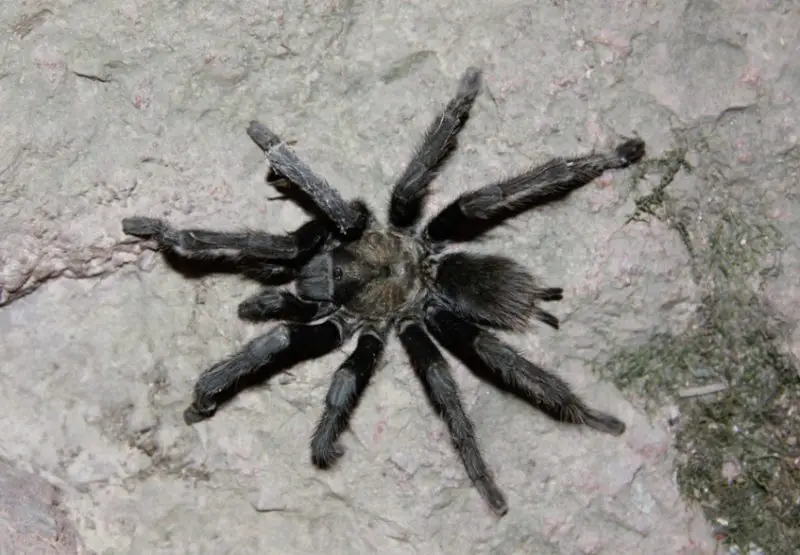
The California ebony tarantula (Aphonopelma eutylenum) is a member of the Theraphosidae family, native to California. They range in color from light beige to ebony.
Females can have a leg span of up to five inches (13 cm) and live up to 25 years, while males mature in 8-12 years and leave their burrows to find a mate. Despite their size, they are not medically significant.
South American Toothed Hacklemesh Weaver
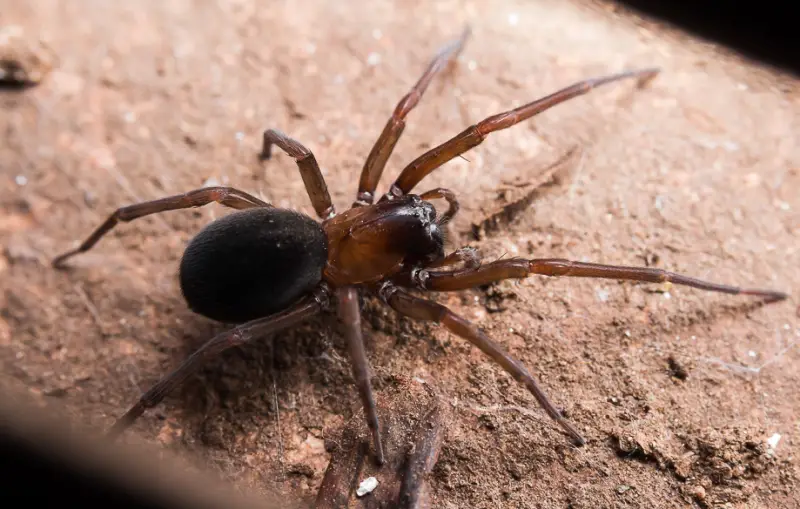
The South American toothed hacklemesh weaver (Metaltella simoni) is a mottled gray spider found under logs in coastal Southern California. Females can grow up to 9mm in length, while males reach 8.5mm.
They feature a brown front head space, gray abdomen with pale chevrons, and males often display orange to yellow on the back of their heads.
Schizocosa mccooki
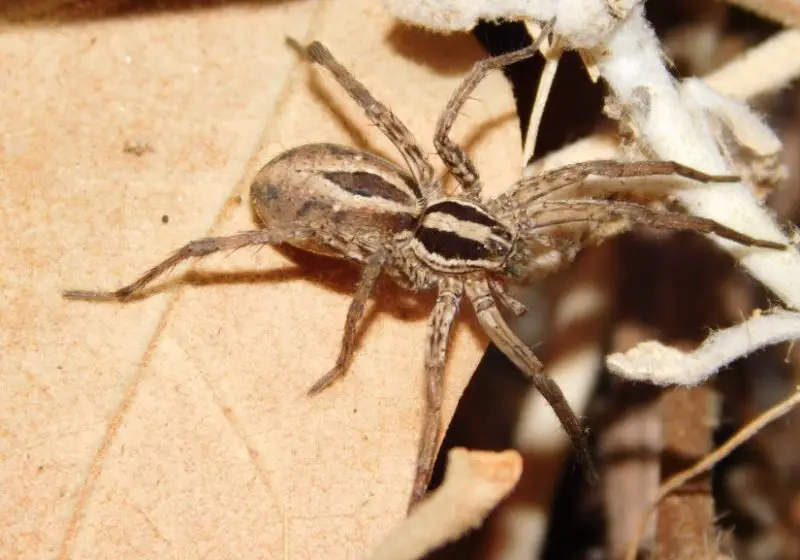
The Schizocosa mccooki, a wolf spider from the Lycosidae family, can reach up to an inch in body length for females and half an inch for males.
They are gray to light brown, featuring two dark bands on the headspace and an oval marking on the abdomen. Light bands flank the oval markings, with white spots outside the bands.
Uloborus diversus

Uloborus diversus is an orb weaver from the Uloboridae family. They are known for their uniquely shaped abdomen and create horizontal or slanted orb webs. Females can grow up to 4mm, while males reach 2.4mm. Juveniles resemble smaller adults.
These spiders are commonly found throughout most of California, excluding the northern counties.
California Trapdoor Spider
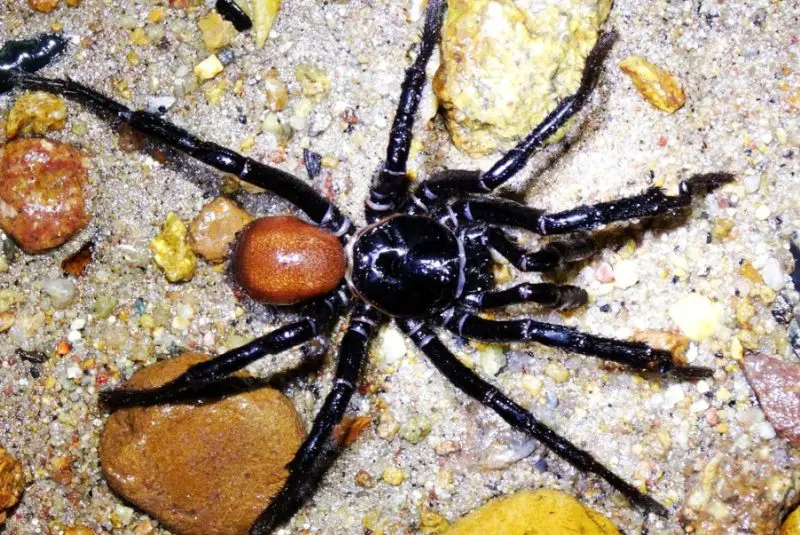
The California trapdoor spider (Bothriocyrtum californicum) is native to southern California. Despite their tarantula-like appearance, they have hairless, shiny black bodies with rusty brown abdomens.
They inhabit burrows up to eight inches deep, camouflaged with leaves and debris, and covered by a silk-hinged door. The spider uses these burrows to ambush prey, which is quickly captured and wrapped in silk for later consumption.
Mediterranean Spiny False Wolf Spider
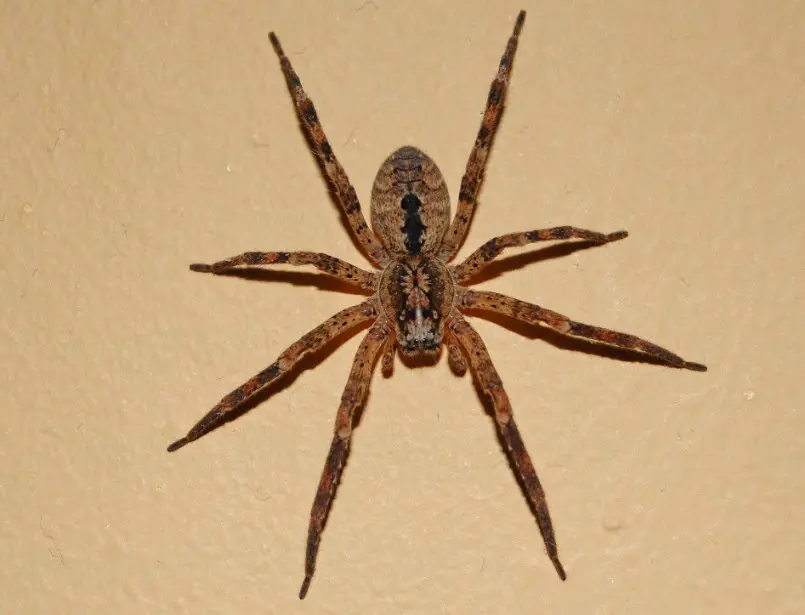
The Mediterranean Spiny False Wolf Spider (Zoropsis spinimana) resembles true wolf spiders but differs in some key features. Females can reach 0.71 inches (18mm) in body length, while males are smaller at 0.47 inches (12mm). Their eyes are more spaced out compared to wolf spiders.
They have a brown body with darker markings and a speckled brown abdomen. Commonly found under rocks, tree bark, and in homes, these spiders are attracted to areas with abundant food and milder temperatures.
Menemerus semilimbatus

Menemerus semilimbatus are large jumping spiders, reaching up to 8.4mm in body length. Males are slightly smaller. They are covered in short gray to white hairs with a white band on their head space, and have large eyes for excellent vision.
Their legs are light brown with dark rings, and their abdomen features yellow or gray with bright V-shaped markings. Common indoors and outdoors, they are often seen on building walls and in gardens, hunting for prey.
Steindachner’s Ebony Tarantula
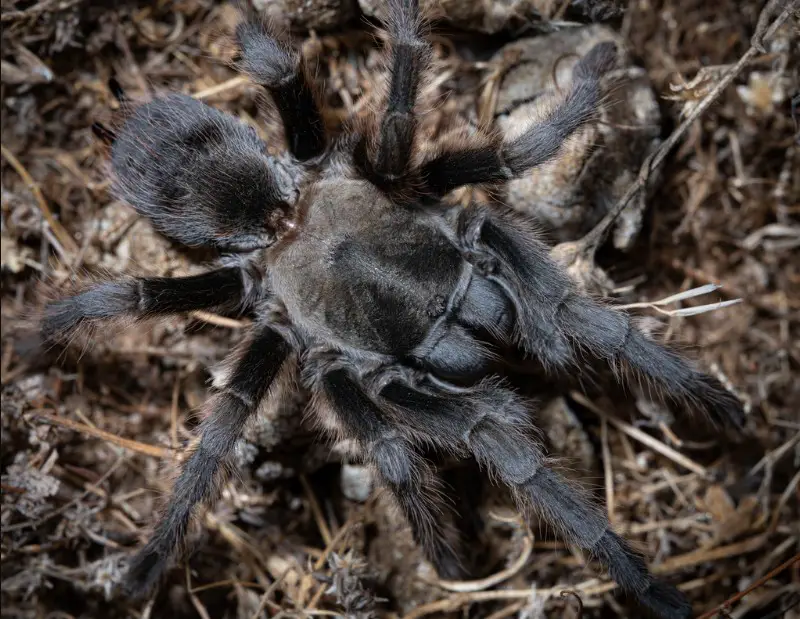
Steindachner’s Ebony Tarantula (Aphonopelma steindachneri) is a large, hairy tarantula from the Theraphosidae family, commonly found in the United States.
Despite their intimidating appearance, they are not considered harmful to humans. Like other tarantulas, they can be unnerving to encounter, but they pose no significant threat.
False Tarantula
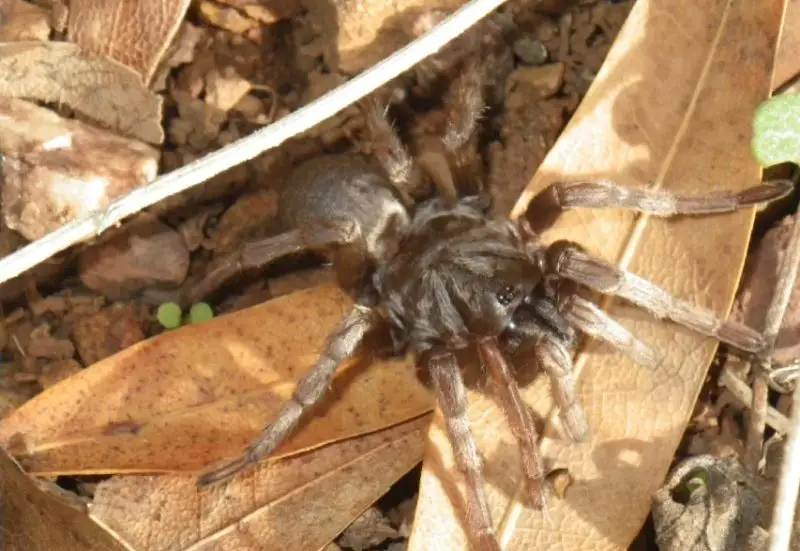
The False Tarantula (Calisoga longitarsis) resembles a tarantula but belongs to the Calisoga genus. Unlike tarantulas with black or red-brown hairs, False Tarantulas have silver-brown hairs.
Common in the Bay Area, they mostly stay hidden in burrows, but males emerge in the fall to seek mates. Their elusive nature makes them rarely observed.
Western Parson Spider
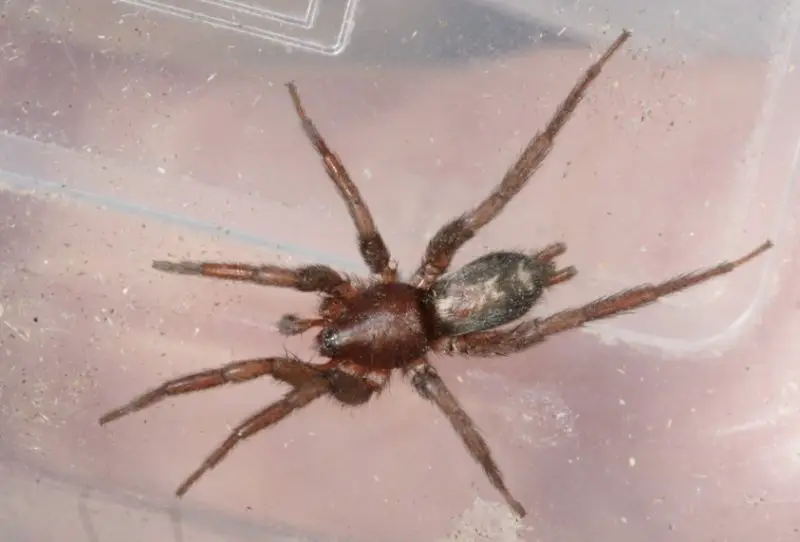
The Western Parson Spider (Herpyllus propinquus) is named for its white stripe, resembling an 18th-century clerical necktie. Medium-sized and hairy, this fast spider hunts at night on walls and the ground, hiding under rocks and debris by day.
Common in homes, it searches for insects. While its venom isn’t lethal, it can cause allergic reactions.
Gem-shaped Orbweaver
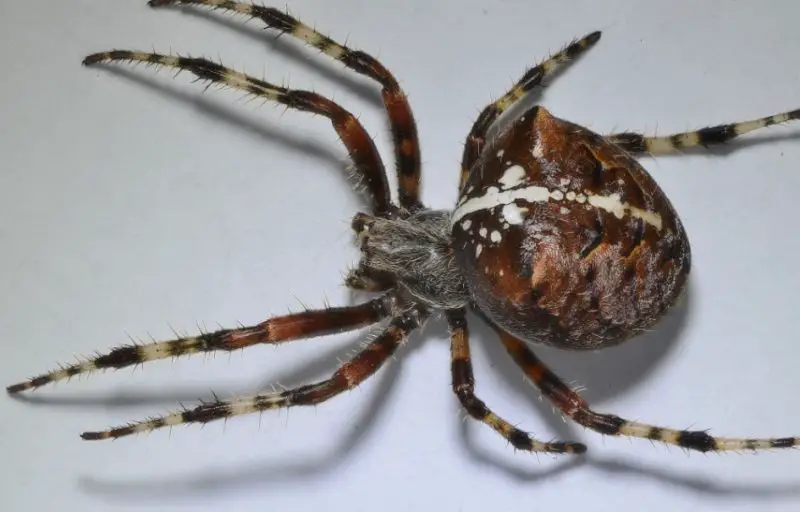
The Gem-shaped Orbweaver (Araneus gemma), or cat-faced spider, is a common outdoor spider known for its distinctive shape. Harmless to humans, it constructs large, orb-shaped webs and hangs upside-down, waiting for prey to get trapped.
These spiders are often seen in gardens and natural areas, where their webs are effective for catching insects.
Wall Spider
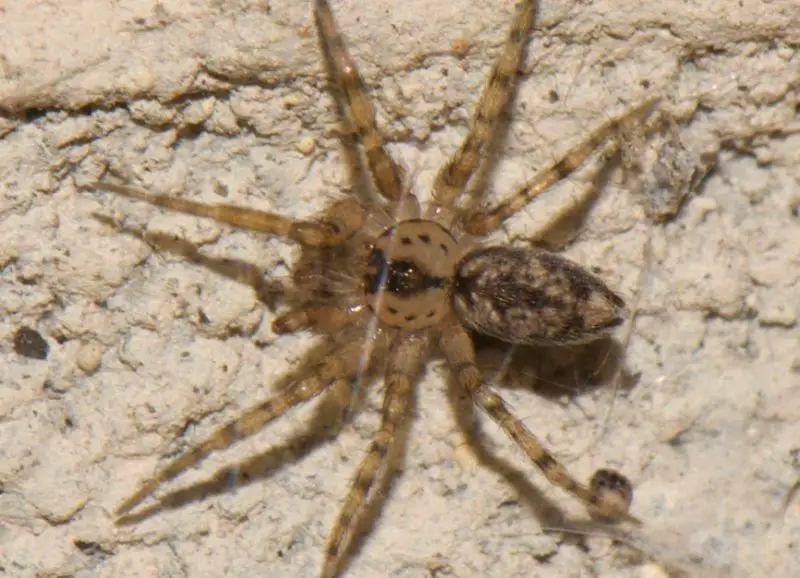
The Wall Spider (Oecobius navus) is a tiny spider, growing to about 3mm in body length. Light gray with darker legs, it is recognized by its flat webs featuring lateral openings of approximately 3mm.
These webs are typically located on ceilings, wall corners, and under rocks. Despite their small size, Wall Spiders are adept at catching small prey.
Sierra Dome Spider
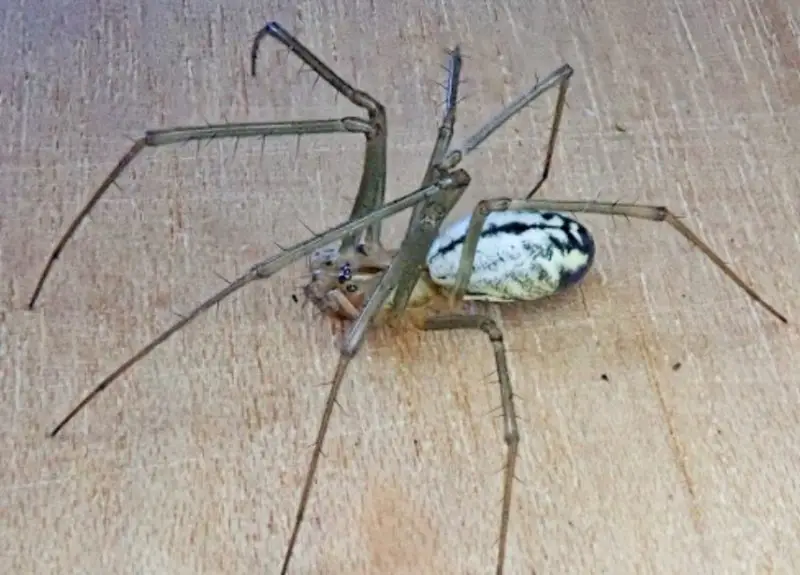
The Sierra dome spider (Neriene litigiosa) is a sheet weaver spider from the Linyphidae family, commonly found in North America.
They build dome-shaped webs strung between bushes, roadsides, and the edges of woods, often at head height. The female spider sits upside down inside the dome, waiting for prey to get trapped in the web.
Johnny Cash Tarantula
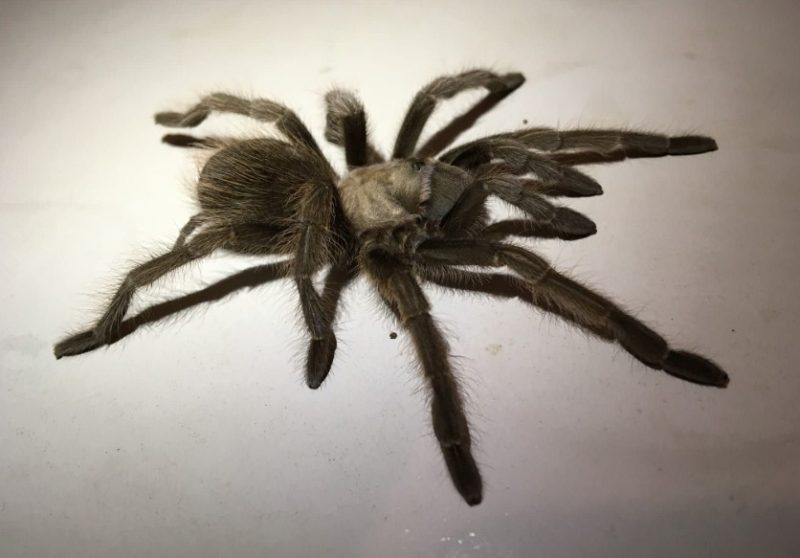
The Johnny Cash tarantula (Aphonopelma johnnycashi) is a tarantula from the Theraphosidae family, discovered in California at Folsom Prison in 2015.
Named after the singer Johnny Cash, males are black while females are dark brown, growing up to 15cm. Though large, they are harmless to humans, with venom that is only mildly irritating.
Araneus andrewsi
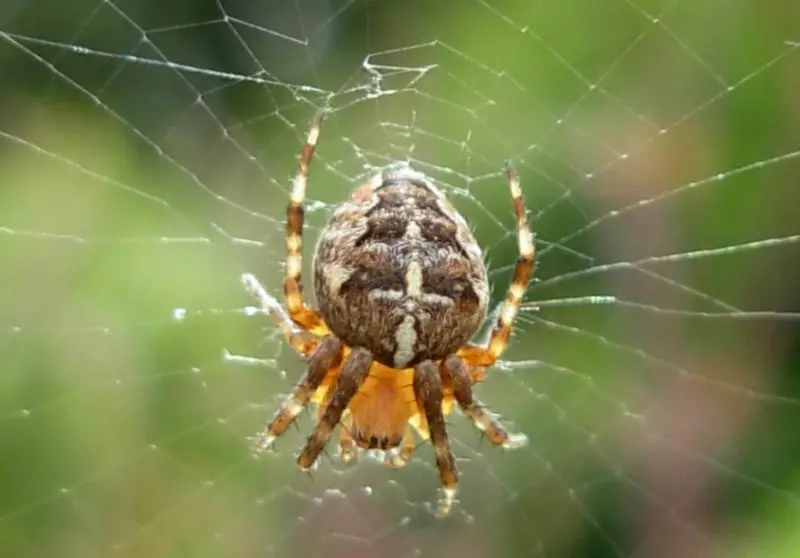
Araneus andrewsi is an orb-weaving spider found across the United States, belonging to the Araneidae family. These spiders create large, orb-shaped webs to capture prey.
The female typically hangs upside down in the center of the web, waiting to detect vibrations signaling trapped prey. They are common garden spiders and are harmless to humans.
Lesser Green Lynx Spider
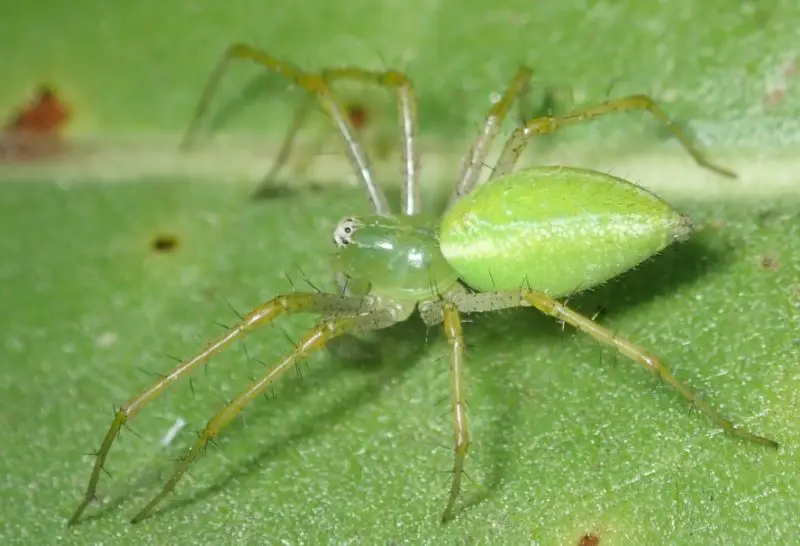
The lesser green lynx spider (Peucetia longipalpis) grows up to 22mm for females and 12mm for males. Bright green in color, they often have white or burgundy diagonal lines on their abdomen, with dark spots on their legs.
While they may defend themselves if threatened, their venom is not harmful to humans, and they are not known to bite frequently.
White-banded Crab Spider
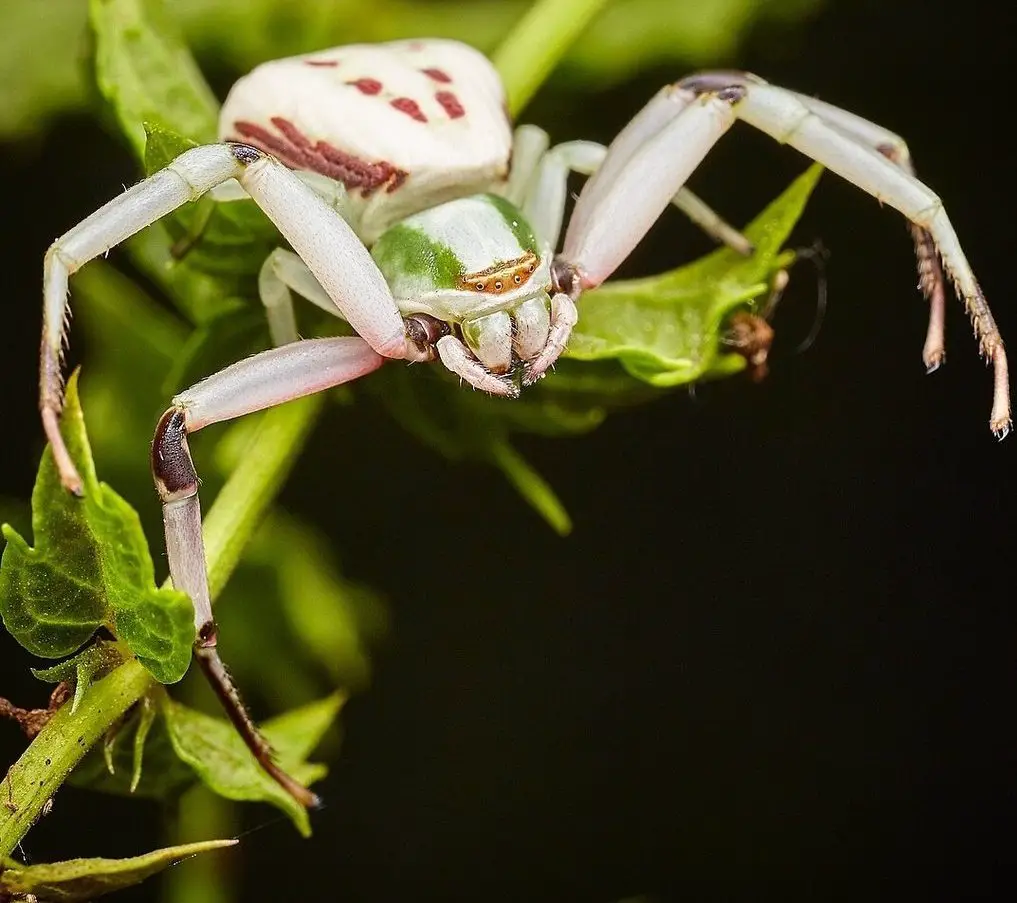
The white-banded crab spider (Misumenoides formosipes) is a sit-and-wait predator from the Thomisidae family, identified by a white line between its eyes. Females grow up to 11.3mm, varying in color between yellow and white to match surroundings. Males are smaller, with darker front legs and a gold abdomen.
These spiders use their strong front legs to capture prey, often much larger than themselves.
Triangulate Combfoot
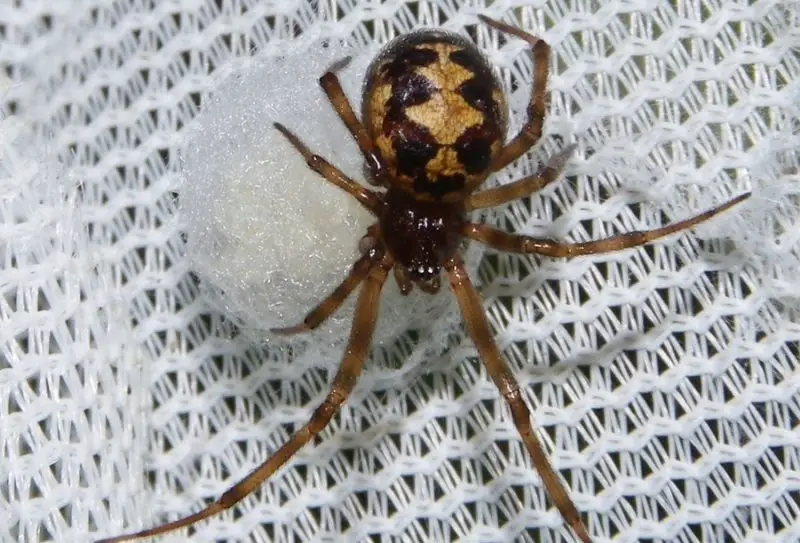
The triangulate combfoot (Steatoda triangulosa) is a small cobweb spider, growing up to 6mm. It has spindly yellow legs, an orange to brown head, and a cream-colored bulbous abdomen with purple to brown zigzag lines.
They create messy cobwebs in dark corners of homes and rely on vibrations to detect prey. These spiders are harmless, with bites causing only minor pain.
Silver-sided Sector Spider
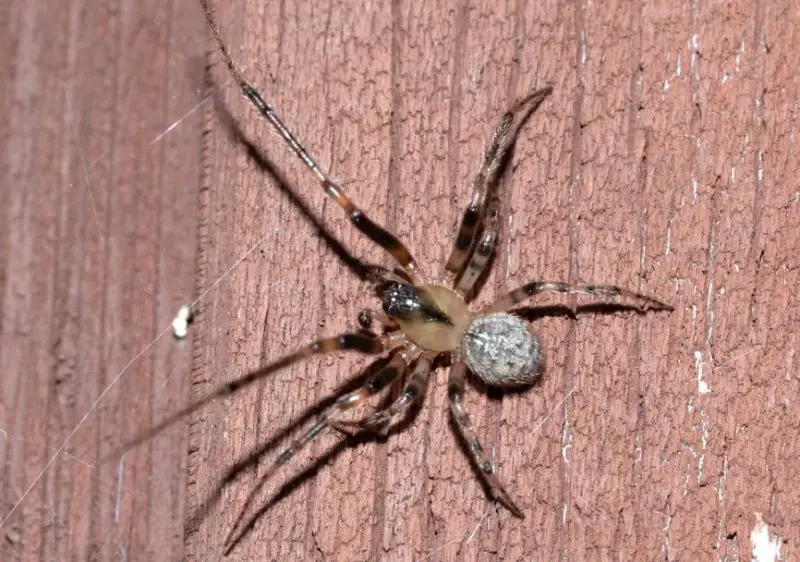
The silver-sided sector spider (Zygiella x-notata), also known as the missing sector orb weaver, is part of the Araneidae family. Females grow up to 11mm and have a silver sheen on their abdomen, while males are smaller at 7mm.
They build orb webs to catch flying insects, relying on vibrations to detect prey. Males stop spinning webs after reaching maturity to search for mates.
Bowl-and-doily Spider
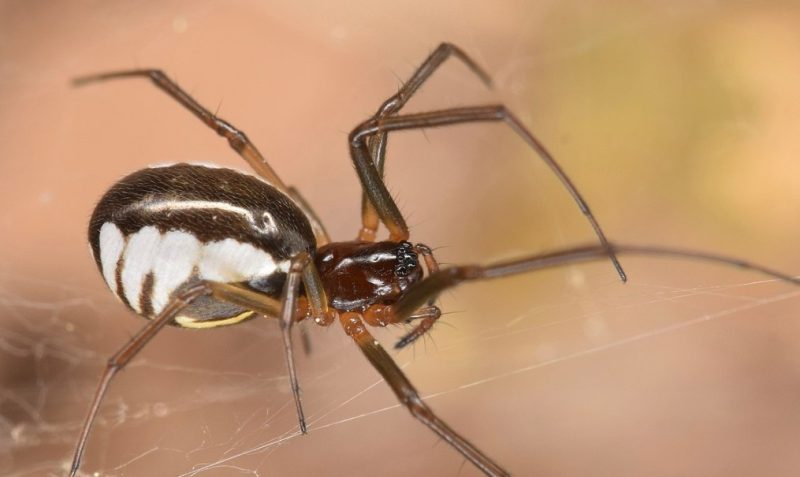
The bowl-and-doily spider (Frontinella pyramitela) is a small sheet weaver that grows up to 4mm in body length. Known for its intricate web structure, it creates a bowl-shaped dome and hangs upside down inside, waiting to catch small flies.
These spiders are red to brown with yellow legs and white markings, commonly found in fields, shrubs, and forests from May to June and September.
Shamrock Orbweaver
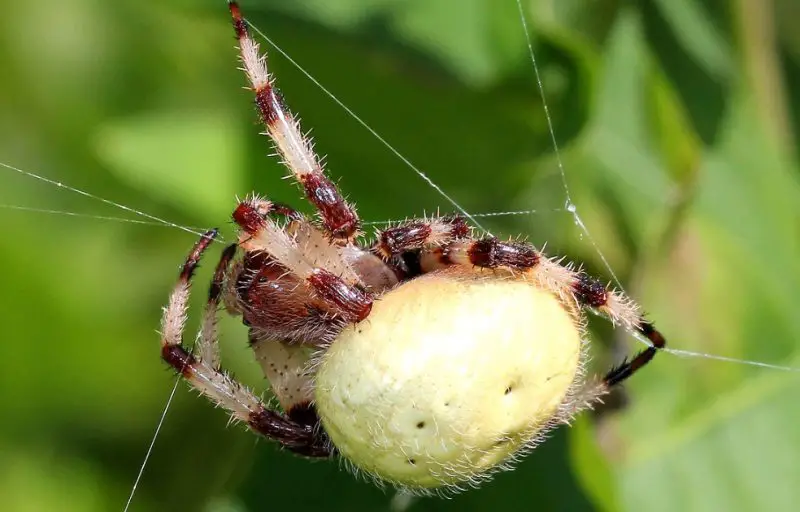
The Shamrock orbweaver (Araneus trifolium) varies in color, typically beige or brown, with some showing green, yellow, or orange on their abdomens. They are identified by several white dots on their backs and brown-to-beige legs with white bands at the joints.
Their large webs, up to two feet wide, capture flying insects. Though their bite can be painful, it’s not medically significant.
Coppered White-cheeked Jumping Spider
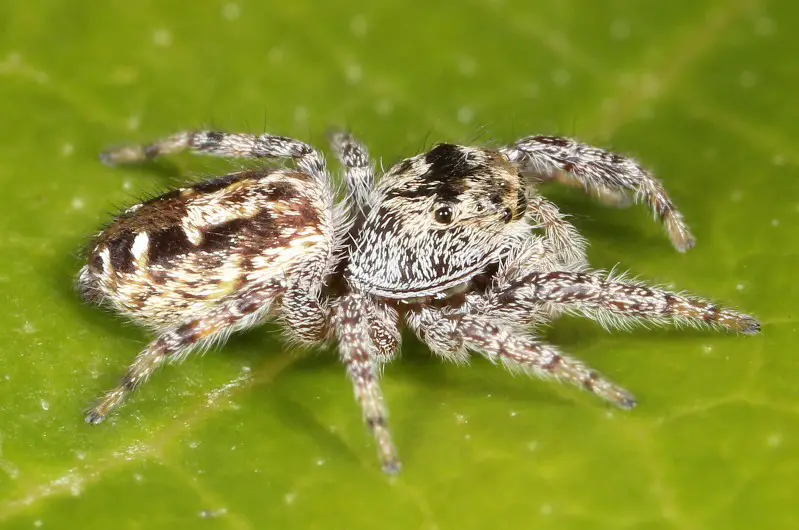
The Coppered White-cheeked Jumping Spider (Pelegrina aeneola) is a small jumping spider from the Salticidae family, found throughout North America. Known for their agility and speed, they are harmless to humans and often curious about people.
They create webs for resting, eating prey, and protecting their eggs until they hatch. Their copper and white coloring makes them easily recognizable.
Giant Crab Spider
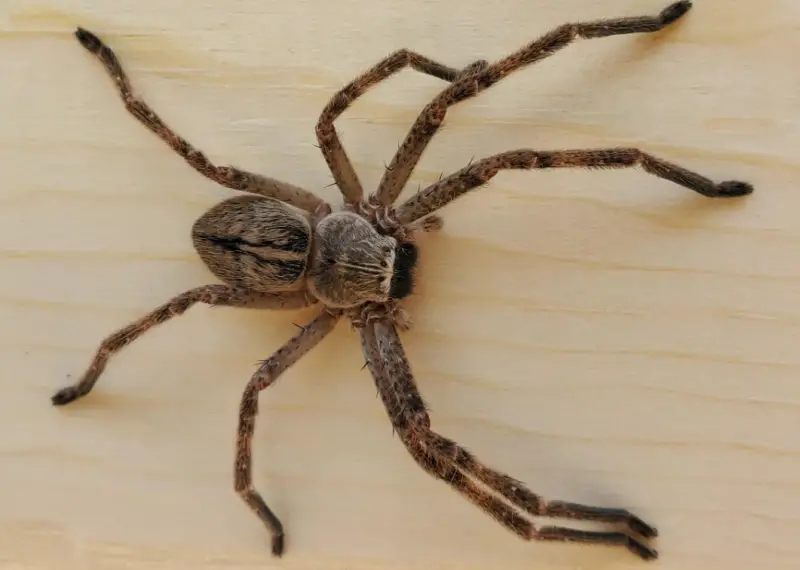
The Giant Crab Spider (Olios giganteus) is a member of the Sparassidae family, characterized by its striking black, orange, or tan coloration.
With a leg span of up to three inches, it resembles a crab and moves in all directions—forward, backward, and sideways. Its front legs are adept at capturing prey, making it an effective predator.
Conical Trashline Orbweaver
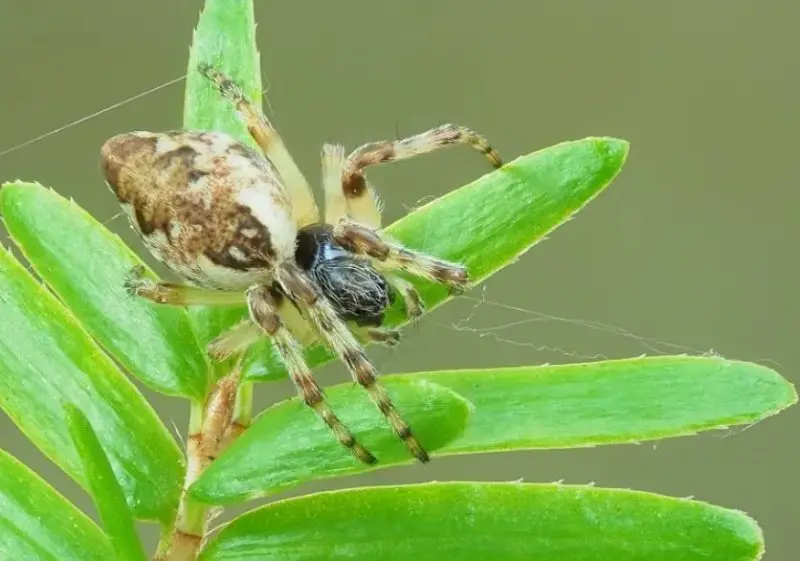
The Conical Trashline Orbweaver (Cyclosa conica) is a small orb-weaver known for its distinctive web, which is adorned with debris for camouflage. These spiders, which can be brown, tan, gray, white, black, rusty red, or yellow, sit in the center of their web with legs tucked up to blend in with the surrounding detritus.
They are commonly found in wooded areas like yards and parks, where they use their web’s blurring effect to evade detection.
Humped Trashline Orbweaver
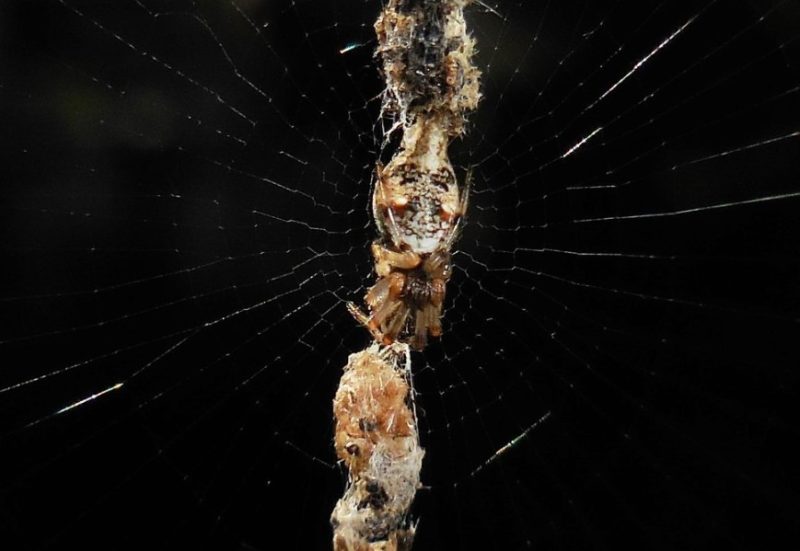
The Humped Trashline Orbweaver (Cyclosa turbinata) is a small spider, reaching about 7mm in length. Its coloration includes a mix of brown, white, and black, with a tapered abdomen.
Although it can bite and has venom, it poses minimal risk to humans and larger pets like dogs and cats, causing no serious injury.
Koch’s Wolf Spider
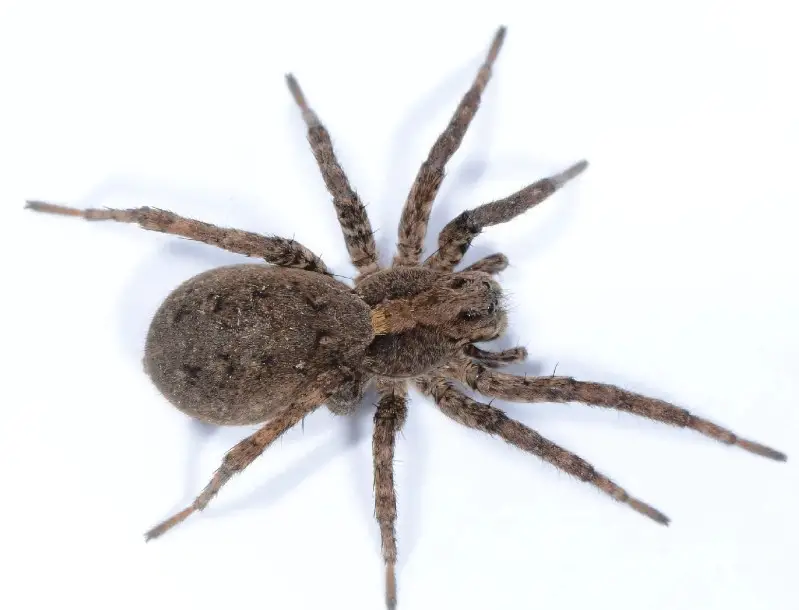
Koch’s Wolf Spider (Alopecosa kochi) is a common North American spider from the Lycosidae family, known for its wandering hunting in dry climates. While not deadly, its bites can be painful and cause uncomfortable symptoms.
Though not dangerous to humans, it’s advisable to consult a doctor if symptoms worsen.
Striped Lynx Spider
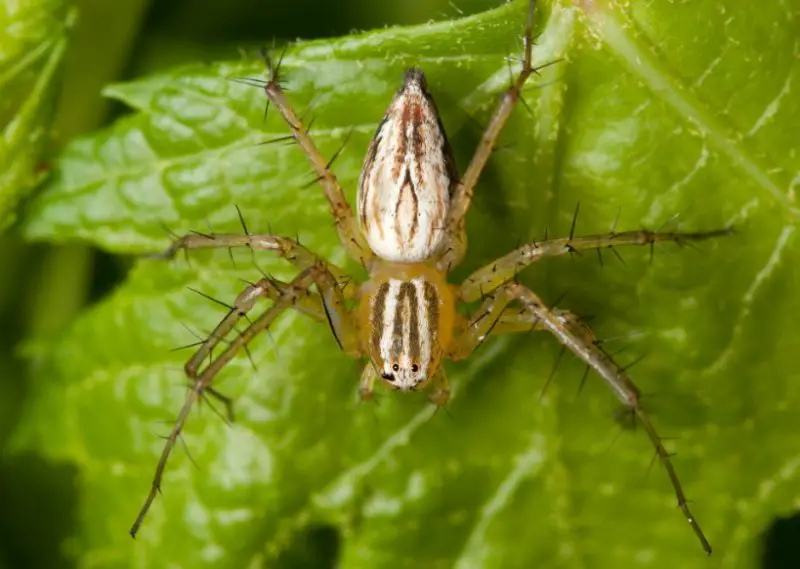
Striped lynx spiders (Oxyopes salticus) display colors ranging from orange and brown to cream, with females having distinct stripes on their head and abdomen.
They often feature a diamond-shaped marking on their legs. Females can grow up to 6mm, while males are smaller, reaching 5mm in body length.
Six-spotted Orbweaver
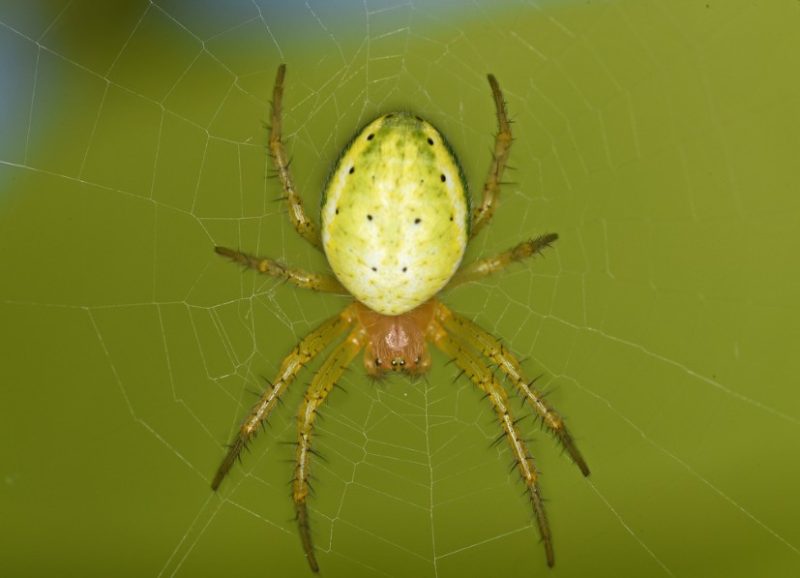
Six-spotted orb weavers (Araniella displicata), as their name indicates, have six distinct spots on their abdomens. Part of the Araneidae family, they create large, orb-shaped webs, which can span up to two meters in diameter.
These spiders hang upside down in their webs, waiting for prey to get caught.
Bull-headed Sac Spider
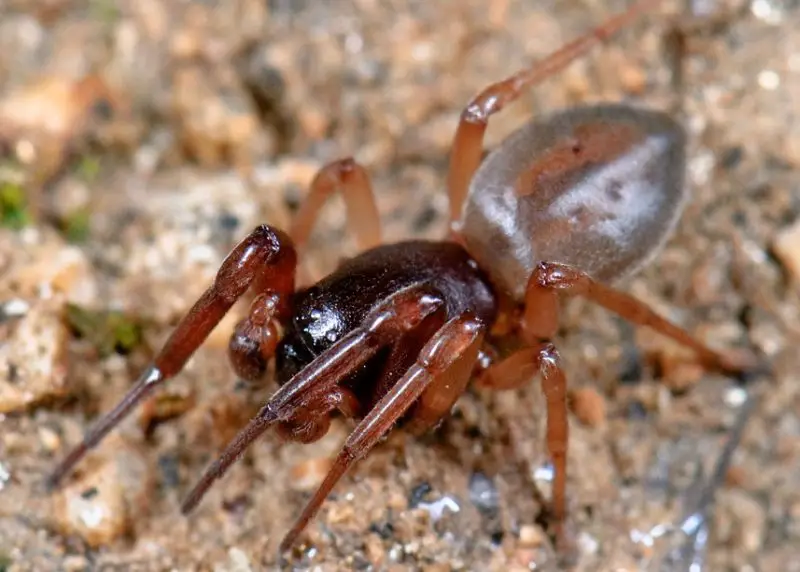
The bull-headed sac spider (Trachelas pacificus), from the Trachelidae family, is common in California homes and buildings. They are nocturnal wandering hunters with a dark magenta head and tan abdomen, featuring large eyes. Females grow to 0.82 mm and males to 0.59 mm.
They are particularly found in California, excluding northern counties, and often lay eggs in grapes.
Ribbon Jumping Spider

Ribbon jumping spiders (Metacyrba taeniola), part of the Salticidae family, have females reaching 0.28 inches (7.2 mm) and males 0.24 inches (6 mm) in body length.
These spiders utilize their impressive jumping abilities to ambush prey, casting a single strand of silk to ensnare and prevent escape. Their agile hunting technique makes them effective predators.
Common House Spider
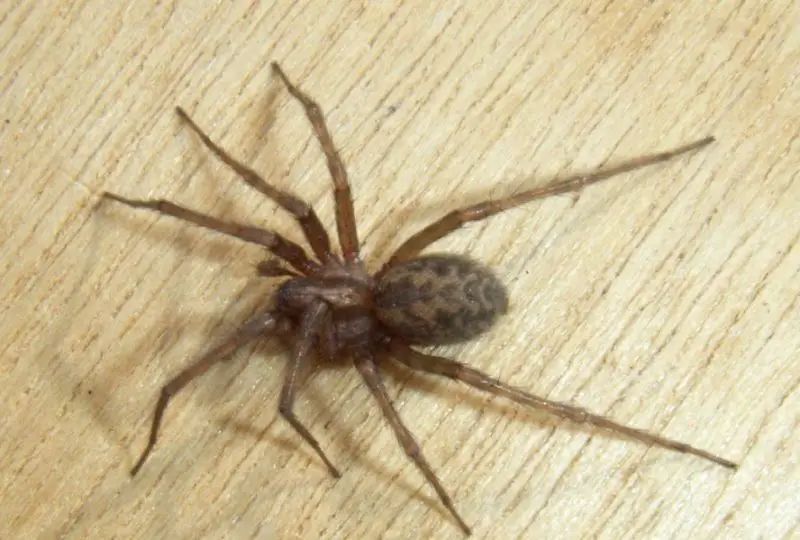
Common house spiders (Parasteatoda tepidariorum) vary in color from tan to black with intricate patterns. Females reach up to 0.24 inches (6mm) in body length, while males are smaller, around 0.19 inches (4.7mm).
Their appearance is similar to widow spiders, aiding in their camouflage. Generally non-aggressive, they may bite if threatened and often play dead when cornered.
Zebra Jumping Spider
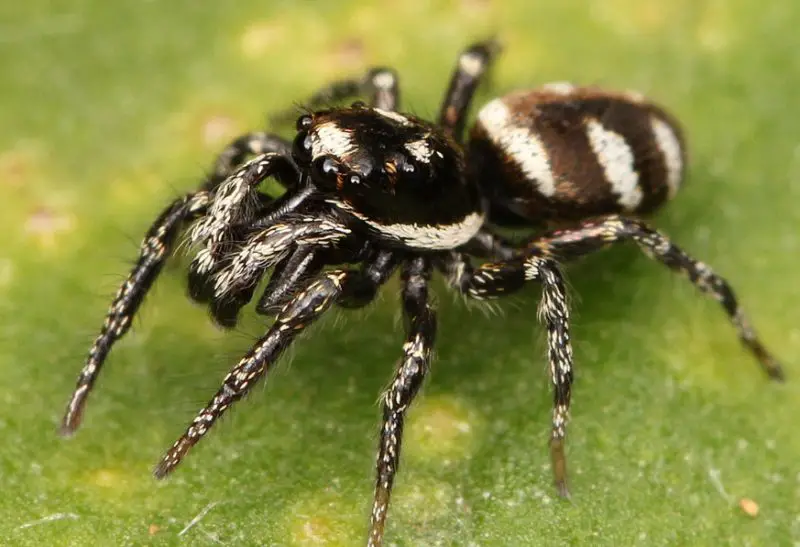
Zebra jumping spiders (Salticus scenicus) reach up to 9mm in length, with males being slightly smaller. They are characterized by their black and white striped hairs.
Commonly found around homes, they inhabit walls, fences, plants, window sills, and behind curtains. These non-harmful spiders are ambush predators, actively hunting for prey.

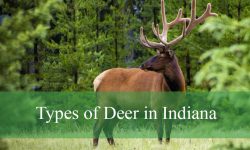
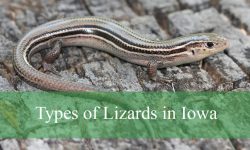
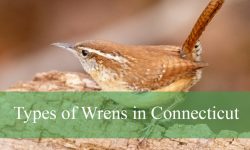
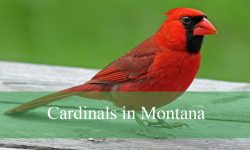
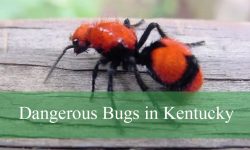

This morning we had a large (about silver dollar including legs) brown spider which I captured and released outside. I believe it is a Koch Wolf Spider due to the markings on it’s back. But…..see our name! I am still laughing.